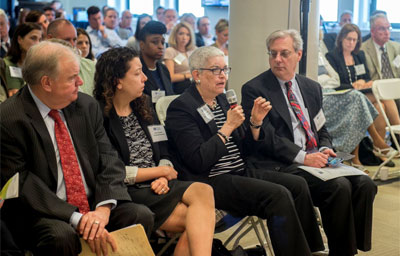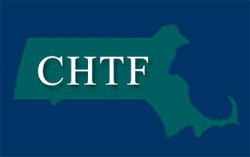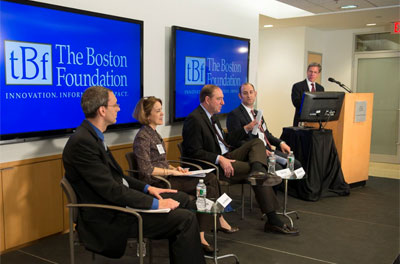Boston Foundation announces $4.3 million in grants to Greater Boston organizations
June 12, 2018
 “Consensus has only grown around smart growth,” said William Reyelt, Principal Planner for the state Department of Housing & Community Development. “Transportation, environmental, housing and economic development agencies have worked together to develop a shared vision” of what it will take to meet Governor Deval L. Patrick’s goal of 10,000 new multifamily housing units per year by 2020, he said.
“Consensus has only grown around smart growth,” said William Reyelt, Principal Planner for the state Department of Housing & Community Development. “Transportation, environmental, housing and economic development agencies have worked together to develop a shared vision” of what it will take to meet Governor Deval L. Patrick’s goal of 10,000 new multifamily housing units per year by 2020, he said.
Smart growth describes a set of urban-planning principles that facilitate safe walking and biking, encourage a range of housing choices, provide for mixed land use, promote environmental sustainability and maximize the use of public transportation to produce thriving neighborhoods.
 Mary Jo Meisner, Boston Foundation Vice President of Communications, Community Relations and Public Affairs, noted that the law and its complement, 40S, sprang from the work of the Commonwealth Housing Task Force convened by the Foundation in 2002. “We’re extremely proud of the role we played in this,” she said. So far, close to 2,200 multifamily units have been permitted or built under 40R and the zoning is in place for a total of 12,350.
Mary Jo Meisner, Boston Foundation Vice President of Communications, Community Relations and Public Affairs, noted that the law and its complement, 40S, sprang from the work of the Commonwealth Housing Task Force convened by the Foundation in 2002. “We’re extremely proud of the role we played in this,” she said. So far, close to 2,200 multifamily units have been permitted or built under 40R and the zoning is in place for a total of 12,350.
David Begelfer, CEO of NAIOP Massachusetts, the Commercial Real Estate Development Association that cosponsored the forum, said “40R and 40S show what can happen when people come together, seeing a pressing need. The job going forward is to get more communities to buy into 40R and get more developers to be aware of the program.”
Mr. Reyelt said the state has already distributed $16.5 million in incentives to the 33 municipalities that adopted 40R zoning districts, where high-density housing can be developed “as of right” in a streamlined process.
State Rep. Kevin G. Honan, the House Chair of the Legislature’s Joint Committee on Housing, praised several key players on the task force – Barry Bluestone, Eleanor White and Ted Carman – and thanked them for “a wonderful law.” Then, as now, he said, the Commonwealth was “desperate for more housing. This program brings civility to development.”
 Four panelists discussed the progress and pitfalls of the past 10 years, and all agreed that 40R has been a helpful tool for communities and developers alike. It allows municipalities to thoughtfully plan for development while giving developers a surer path to project approvals. “It creates a great structure for talking about complex issues and complex projects,” said panelist Ted Tye, Managing Partner of National Development. He said his firm’s conversion of a golf course into 180 housing units plus retail and office space would not have happened without the law.
Four panelists discussed the progress and pitfalls of the past 10 years, and all agreed that 40R has been a helpful tool for communities and developers alike. It allows municipalities to thoughtfully plan for development while giving developers a surer path to project approvals. “It creates a great structure for talking about complex issues and complex projects,” said panelist Ted Tye, Managing Partner of National Development. He said his firm’s conversion of a golf course into 180 housing units plus retail and office space would not have happened without the law.
Adam Costa, an attorney who has worked with towns and cities on smart growth projects, noted that opportunities for public input are built right into 40R, allowing for negotiations about density, design standards, and other matters in a non-contentious manner.
Matt Zahler, Project Manager for Trinity Financial, said the 40R district created by the city of Brockton “set the framework for us to come in with a plan.” Within three months of proposing their 3.4-acre mixed-use project downtown, approvals were in hand.
Moderator Robert A. Fishman, a senior partner at Nutter, McClennen & Fish, noted that 40B “wrings a lot of the discretion out of what is often a special permit process.”
Lisa B. Alberghini, president of the Boston Archdiocese’s Planning Office for Urban Affairs and a member of Mayor Martin J. Walsh’s Housing Task Force, discussed her nonprofit’s conversion of a historic mill complex in downtown Haverhill into 57 units of mixed-income housing and retail space. “It was one of the most productive development efforts we have ever been involved with,” she said. “The process was predictable, the standards were clear and the approval process was timely.”
She praised city officials for their leadership and vision and their help in getting zoning approvals in one night. The project, known as the Hayes at Railroad Square, reinvigorated the downtown streetscape, brought $600,000 in state incentive payments to the city, and is serving as a catalyst for future development nearby.
She commended the governor for his ambitious goal for more housing, saying, “To create a goal as bold as 10,000 units a year is quite unusual and I hope the next governor will keep that commitment.”
